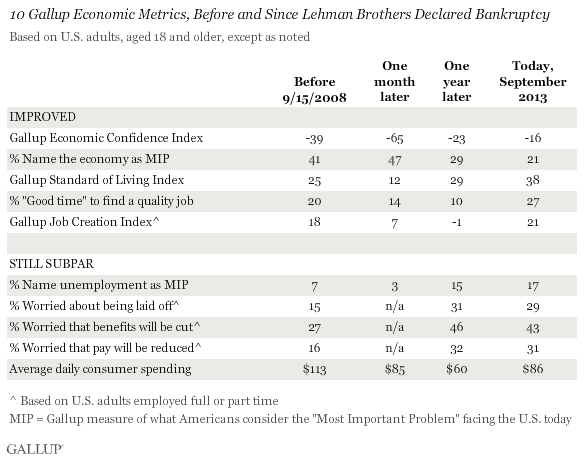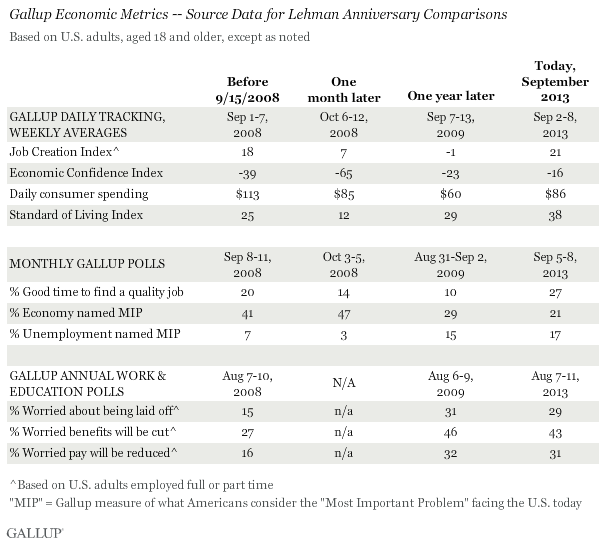PRINCETON, NJ -- On Sept. 15, 2008, the collapse of Lehman Brothers, one of the nation's leading banking institutions, triggered not only a global economic contraction, but a sharp downturn in Americans' confidence in the economy on many levels. Americans' views have since bounced back on certain Gallup core economic measures, even exceeding where they stood just prior to Lehman's demise, but have not yet recovered on others.

Americans' Broad Economic Views Are Most Improved
Of 10 economic-oriented metrics that Gallup has tracked routinely since at least 2008, Americans' overall evaluations of the economy, as summarized in Gallup's Economic Confidence Index, have improved the most since the Lehman bankruptcy. The index was already quite negative in the days just before Lehman Brothers filed for Chapter 11 protection -- at -39 -- but it plummeted to -65 the following month. A year later, the index was up to -23, and today is slightly better than that, registering -16 in the first full week of September.
In line with these changes, the percentage of Americans naming the economy, when asked to identify the "most important problem" facing the country, first increased from 41% in early September 2008, before Lehman's fall, to 47% a month later. By the following year, this had declined to 29%; it now stands at 21% -- a marked improvement over 2008.
Gallup trends also document significant gains since 2008 in how Americans view their standard of living, as well as in their perceptions of job market conditions. Gallup's Standard of Living Index -- a summary of whether Americans are satisfied or dissatisfied with their own standard of living, and whether they think it is getting better or worse -- dipped 13 points to +12 in the month after Lehman Brothers' fall. However, a year later, it had more than recovered to +29, and is now better still, at +38.
Americans' views about national conditions for finding a good job soured a bit after Lehman, and continued to fall through 2009 (and beyond), but have since improved. Today, 27% say it is a good time to find a quality job, higher than immediately before Lehman, although the great majority -- 70% -- still say it's a bad time. The same pattern is evident in U.S. workers' reports of hiring conditions where they work. Gallup's Job Creation Index now stands at +21, up from -1 in September 2009 and +7 in October 2008, but also slightly improved over the +18 found before Lehman's fall in early September 2008.
Despite clear improvements in Americans' views of the economy as a whole, as well as their own economic circumstances and job market conditions, the 17% this month who name unemployment as the nation's top problem is significantly higher than in 2008, both before and after Lehman's fall. While this indicator rose even higher in 2011 and 2012, reaching 39% in September 2011, concern about unemployment still hasn't eased to its 2008 levels.
Relatedly, the percentage of workers saying they are worried about each of several setbacks at work -- including being laid off, and having their benefits or pay reduced -- are all as high today as they were a year after the fall of Lehman, and nearly double the levels seen in the month prior to Lehman.
Spending Falls Short of Pre-Lehman Days
Consumers' self-reported discretionary spending in the first week of September this year averaged $86 per day, below the $113 average recorded the same week in 2008. Spending was $85 per day a month after the fall of Lehman Brothers, but sank to $60 on the first anniversary of Lehman's demise, in September 2009, as the impact of high unemployment on retail spending was being felt amid the prolonged recession. While spending has been up somewhat this year -- consistently averaging $80 or more each month, compared with below $80 each month from January 2009 to November 2012 -- it has yet to routinely break the $90 mark, as was the norm prior to Lehman.
The precise survey dates for each Gallup economic metric discussed in this report are shown on page 2.
Bottom Line
The failure of Lehman Brothers in 2008 and the broader economic events that ensued, related to the housing bubble and overleveraged banks, sent major shock waves through the economy and public opinion that are still being felt. Just as some parts of the economy have improved more than others, some aspects of Americans' economic views have been more resilient. Americans' broad views about the economy are substantially brighter now than they were immediately before and shortly after Lehman Brothers' fall. Workers' perceptions about hiring and Americans' general impressions of the job market are also improved, although the latter remain mostly negative.
Significant progress has been made in consumer spending, according to Americans' self-reports of how much they spend each day at retail stores, online, and on gas. However, while it is up from the low points recorded in the first few years of the global financial crisis, the $86 average seen in early September remains below the level seen at the same time in 2008, and for much of the first half of that year.
The most significant impact of the economic crisis that started with Lehman Brothers -- and that may help explain the continued damper on consumer spending -- appears to be Americans' rattled confidence in their own jobs. The percentage of workers worried about being laid off remains double what it was prior to Lehman. And, more broadly, while down from 30% or more a few years ago, the 17% now naming unemployment as the nation's most important problem remains much higher than the 7% recorded before Sept. 15, 2008. While not a direct result of Lehman's fall, this clearly reflects the high unemployment that ensued, and that remains the living legacy of that singular bankruptcy filing.
Gallup.com reports results from these indexes in daily, weekly, and monthly averages and in Gallup.com stories. Complete trend data are always available to view and export in the following charts:
Daily: Employment, Economic Confidence, Job Creation, Consumer Spending
Weekly: Employment, Economic Confidence, Job Creation, Consumer Spending
Read more about Gallup's economic measures.
View our economic release schedule.

